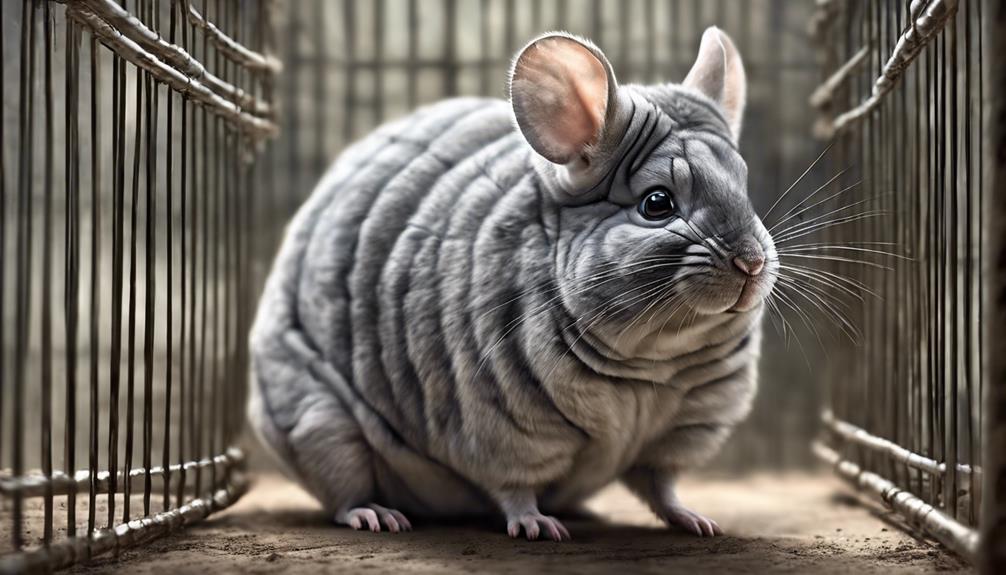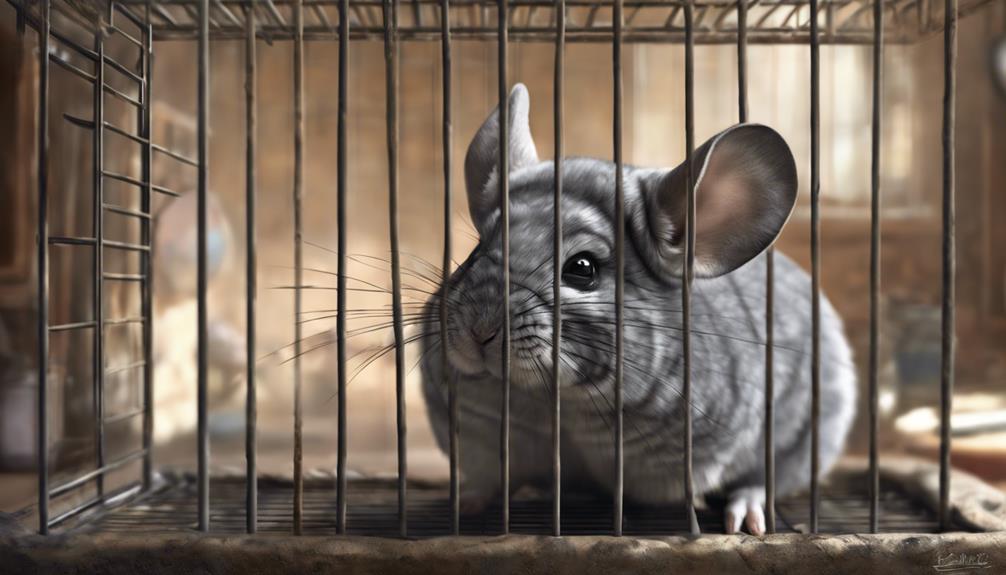Why Proper Cage Bar Spacing Is Crucial for Chinchilla Safety

Chinchillas are small animals that are known for their agility and curiosity. They are also known for their ability to squeeze through small spaces and escape from enclosures. This is why it is crucial to have proper cage bar spacing when housing chinchillas.
Inappropriate cage bar spacing can lead to serious injuries or even fatalities for chinchillas. They may try to squeeze through the bars and get stuck, leading to broken bones or other injuries. Additionally, chinchillas are known to chew on anything they can reach, so if the bar spacing is too wide, they may chew on the bars and injure themselves in the process.
Proper cage bar spacing is essential for the safety and well-being of chinchillas. It helps prevent escape, injuries, and other potential hazards that could harm these small and delicate animals. By ensuring that the cage bars are spaced appropriately, chinchilla owners can create a safe and secure environment for their pets to thrive.
Key Takeaways
- Proper cage bar spacing ensures chinchilla safety and well-being.
- Incorrect spacing poses risks of choking hazards and escapes.
- Injury prevention and security are enhanced with appropriate bar spacing.
- Customization and maintenance play vital roles in maintaining a safe chinchilla environment.
Importance of Cage Bar Spacing
The appropriate spacing between cage bars is essential for the safety and well-being of chinchillas. Ensuring that the cage bars are properly spaced allows these active creatures to move freely within their enclosure, promoting exercise and reducing stress. When the bars are too wide, chinchillas may attempt to squeeze through, risking injury or escape. On the other hand, bars that are too narrow can hinder their movement and may lead to frustration or even physical harm.
Chinchilla exercise is vital for their physical and mental health. Cage safety is paramount when considering the well-being of chinchillas. By maintaining the correct bar spacing, owners provide a secure environment where these small animals can thrive. It's the responsibility of chinchilla caretakers to carefully select cages with appropriate bar distances to prevent accidents and promote a healthy lifestyle for their pets. Remember, freedom for chinchillas begins with safe and adequately spaced cage bars.
Risks of Incorrect Spacing
Owners must understand that incorrect cage bar spacing poses serious risks to chinchillas. Choking hazards can arise when the spacing allows for small heads to get stuck.
Highlighting the potential for escapes and the necessity of injury prevention strategies will underscore the importance of proper bar spacing in chinchilla cages.
Choking Hazards Explained
With incorrect spacing in chinchilla cage bars, potential choking hazards lurk, endangering the small pet's well-being. To prevent accidents, ensuring proper bar spacing is important.
Chinchillas are curious creatures that may try to squeeze through bars that are too wide apart. If successful, they could get their heads stuck, leading to serious injuries or even death. Safety measures must be taken to avoid such risks.
Owners should regularly inspect their chinchilla's cage for any gaps that could pose a threat. Choosing cages with appropriate bar spacing is necessary to maintain a safe environment for these adorable pets.
Escape Possibilities Highlighted
Properly spaced cage bars are important to prevent chinchillas from escaping and risking harm to themselves. Chinchillas are curious creatures and will exploit any opportunity to explore beyond their designated space. Incorrect spacing can lead to various escape possibilities, putting your chinchilla at risk.
To guarantee their safety and prevent accidents, it's essential to prioritize security features such as:
- Narrow Bar Gaps: Make sure the gaps between cage bars are too narrow for a chinchilla to squeeze through.
- Secure Locking Mechanisms: Use reliable locking mechanisms to prevent chinchillas from opening the cage doors.
- Durable Materials: Opt for sturdy cages made of durable materials to withstand escape attempts.
- Regular Inspections: Consistently check for any wear and tear on the cage to maintain its security features.
Injury Prevention Strategies
To safeguard your chinchilla from potential injuries, ensuring the cage bars are appropriately spaced is paramount. Preventing accidents is imperative in maintaining your pet's safety.
By providing safe playtime alternatives, such as chinchilla-proofed rooms or playpens, you can minimize the risks associated with improper cage bar spacing. Secure enclosure options, like cages with narrow bar spacing or solid walls, are essential for avoiding dangers that could lead to injuries.
Always inspect the cage regularly to check for any signs of wear or damage that could compromise the safety of your chinchilla. Remember, a proactive approach to injury prevention is key in creating a secure environment for your furry friend.
Chinchilla Behavior Considerations
Chinchilla behavior considerations are vital when choosing a cage with appropriate bar spacing. Understanding chinchillas' chewing habits and their natural inclination to attempt escape is essential.
Chinchilla Chewing Habits
Considering the natural chewing habits of chinchillas is essential when setting up their living environment. Chinchillas have a strong need to chew to keep their teeth healthy and their minds stimulated. Here are some key points to keep in mind regarding chinchilla chewing habits:
- Provide Chew Toys: Offering safe wooden toys can help satisfy their natural urge to chew.
- Avoid Unsafe Materials: Make sure that any items within their reach are non-toxic and chinchilla-safe.
- Rotate Chew Items: Keep their environment interesting by rotating different chew toys regularly.
- Monitor Chewing Behavior: Regularly observe their chewing habits to make certain they're engaging in appropriate chewing activities.
Understanding and accommodating these chewing habits are essential for the well-being of your chinchilla.
Escape-Proof Cage Design
Understanding the behavioral tendencies of chinchillas is paramount when designing an escape-proof cage that guarantees their safety and security. Chinchillas are known for their agility and curiosity, making it essential to incorporate cage modifications that adhere to strict safety standards.
To prevent potential escapes, cage bars must be spaced close enough to prevent squeezing through, with no gaps that could entrap them. Additionally, ensuring that the cage has secure locks and latches will further enhance its escape-proof qualities.
Health Implications of Wrong Spacing

What potential risks do chinchillas face when exposed to incorrect cage bar spacing? Improper cage bar spacing can lead to various health implications for chinchillas, affecting their overall well-being and safety. Here are some critical points to keep in mind:
- Injuries: Chinchillas can get their limbs, head, or other body parts stuck in wide gaps between cage bars, resulting in serious injuries or fractures.
- Stress: Being exposed to incorrect spacing can cause chinchillas to feel anxious and stressed, impacting their mental health and leading to behavioral issues.
- Dental Problems: Chinchillas may try to gnaw on bars that are too widely spaced, leading to dental problems such as overgrowth or misalignment.
- Risk of Escapes: Chinchillas may attempt to escape through bars that aren't closely spaced, putting them at risk of getting lost or injured outside their cage.
Ensuring the correct spacing between cage bars is essential to safeguard the health and well-being of these small, freedom-loving creatures.
Choosing the Right Cage Bars
To guarantee the safety and well-being of chinchillas, the selection of appropriate cage bars is paramount. When choosing the right cage bars, consider the material options available. Opt for sturdy materials such as metal to assure durability and security for your chinchilla. Avoid bars that are too widely spaced or made of weak materials that could pose a danger to your pet.
While prioritizing safety, don't overlook the aesthetic aspect of cage bars. Many cage bars come in various designs and finishes, allowing you to select decorative cage accents that not only enhance the look of the enclosure but also provide a safe environment for your chinchilla. Remember, functionality should never be compromised for style when it comes to choosing cage bars for your furry friend.
DIY Solutions for Bar Adjustments

For effective adjustment of cage bars, chinchilla owners can explore simple do-it-yourself solutions that prioritize safety and comfort for their pets. By employing adjustment techniques and custom modifications, chinchilla cages can be tailored to meet the specific needs of these adorable pets.
Here are some DIY solutions for bar adjustments:
- Padding: Adding soft padding around the cage bars can prevent chinchillas from getting stuck or injured.
- Bar Covers: Installing custom bar covers made of safe materials can help narrow the gaps between bars.
- Divider Panels: Utilizing divider panels within the cage can create separate sections, adjusting the spacing to suit chinchilla size.
- DIY Extensions: Crafting DIY extensions to existing bars can effectively reduce the space between them, ensuring chinchilla safety.
With these creative solutions, chinchilla owners can customize their cages to provide a secure and cozy environment for their furry friends, promoting freedom of movement while maintaining a safe living space.
Monitoring and Maintenance Tips
Regular monitoring and maintenance of chinchilla cages is crucial to guarantee a safe and comfortable environment for these delicate pets. To make sure the well-being of your chinchilla, conduct regular safety checks on the cage bars and overall setup. Here are some essential tips for cage maintenance and monitoring:
| Cage Bar Maintenance | Proper Cage Setup | Space Requirements |
|---|---|---|
| Check for any loose or broken bars that could harm your chinchilla. | Set up the cage in a quiet area away from direct sunlight and drafts. | Provide adequate space for your chinchilla to move around, exercise, and explore. |
| Tighten any loose screws or fastenings to secure the bars in place. | Use appropriate bedding material to make certain comfort and cleanliness. | Include platforms and shelves for vertical movement and mental stimulation. |
| Regularly inspect the cage for signs of wear and tear that could compromise safety. | Offer a variety of toys and accessories for enrichment. | Make sure the cage is large enough to accommodate exercise wheels and other essential accessories. |
Frequently Asked Questions
Can Chinchillas Escape From Cages With Incorrect Bar Spacing?
Have chinchillas slipped through cage bars? These escape artists, with their agile behavior, can indeed exploit incorrect spacing. Assure cage security; use proper prevention measures to safeguard against their cunning escape attempts.
How Often Should Cage Bar Spacing Be Checked and Adjusted?
Regularly check cage bar spacing to guarantee chinchilla safety. Adjustments must be made promptly if bars are too wide. Engage in this essential task frequently, showing care for your pet's well-being and freedom.
Are There Any Specific Chinchilla Breeds That Require Special Cage Bar Spacing Considerations?
In the world of chinchillas, different breeds require special cage bar spacing considerations. Selecting wisely ensures these furry friends roam free yet safe. Understanding the unique needs of each breed is paramount.
Can Incorrect Cage Bar Spacing Lead to Behavioral Issues in Chinchillas?
Incorrect cage bar spacing can lead to behavioral changes in chinchillas, causing stress indicators like excessive chewing or attempts to escape. To prevent this, owners should make necessary cage modifications for chinchilla safety and well-being.
Are There Any Warning Signs to Look Out for That Indicate the Cage Bar Spacing Is Incorrect for My Chinchilla?
Signs of discomfort in chinchillas due to improper cage bar spacing are vital warnings. Owners should prioritize safety precautions by observing for behaviors like escape attempts, injuries, or stress. Addressing these signs promptly guarantees chinchilla well-being.











